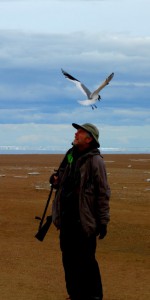The first Black Guillemot chicks are hatching in the colony this week and they are just as cute as they are fluffy. There are currently 114 nests with parent birds sitting on eggs or brooding chicks which is making this a productive nesting season and gives us a lot to do each day as we monitor the population. I arrived on the island on July 15th and am up early each day, excited to open nest boxes and discover the newly hatched Black Guillemot chicks. It is a busy time for George and I am trying to help by recording data, checking nests, and assisting with bird banding. I am learning a lot about what it means to be a field scientist, how to collect and record data in the field, and the Black Guillemots that George has spent so much time studying and observing. I’m looking forward to taking this experience back to my students at University Child Development School in Seattle, WA.

I was worried that life on the island would be a big adjustment to my normal city life, but it has been quite comfortable. George is a creative chef, has a fully-stocked kitchen and we have eaten well. Friends stopped by after caribou hunting and brought us filet mignon, corn on the cob, and salad. Fresh produce is a real treat! The cabin is typically 10-15 degrees warmer than 40 degree temperatures outside and feels cozy and comfortable. Email and a few satellite phone calls to my husband and two daughters have kept me connected to home and not feeling too homesick. George has a great library of Arctic-related books and Ice Master, the tale of a vessel trapped and broken by the sea ice just north of Cooper Island a century ago, has been keeping me busy when I am not helping enter data or swapping stories with George. Long days in the field have made it easy to sleep even though it stays light all night.
Mornings are the best time to monitor the nests, so we have been doing chores around camp and exploring the island in the afternoon and evenings. There are many artifacts of past activity on the island and when we walk around George stops often to tell the stories and the history of these finds. One evening we walked east on the tundra-like landscape, discovering where the Arctic fox had been eating Brant eggs, a polar bear sleeping den (old), and some whale bones. We stirred up the Arctic Terns and Sabine’s Gulls, who had nests in the area. The terns squawked and circled but the Sabine’s dive bombed our heads repeatedly. They also landed and walked around pretending to be injured. We were very surprised to happen on a Sabine’s chick and the determined attack on us was explained. In my home state of Washington you have to take a trip out on the ocean for a chance to glimpse a Sabine’s gull so I was delighted to add this to my bird list – and get to see them up close as they tried to hit me in the head!

The weather has been surprisingly mild, even a little too mild with a high of 61 degrees one day! This warm weather sure makes the mosquitos active and we have had a few very buggy days. There is no fresh water on Cooper Island to support mosquitos but with a slight wind from the mainland and warm temperatures thousands of them will make the three mile trip to visit us. Just when I think I can’t take them anymore, the wind picks up and blows them out to sea! Somehow, the mosquitos don’t seem to phase George in the least. Only me!
I only have a few more days to enjoy the hatching Black Guillemot chicks and their engaging parents. Guillemot chicks remain in the nest for 35 days – one of the reasons they are an excellent monitor of the Arctic Ocean ecosystem. Chicks are weighed each day to monitor food intake and cameras track the types of fish that parents are bringing back to the nest. The chicks will have a ten-fold increase in size and be independent when they leave the nest. The late fledglings will be starting their life in the Arctic just as my students are starting their new school year.
–Katie Morrison